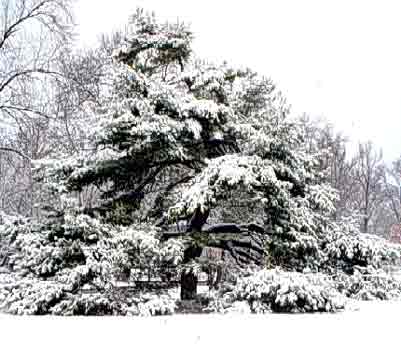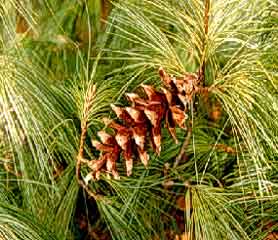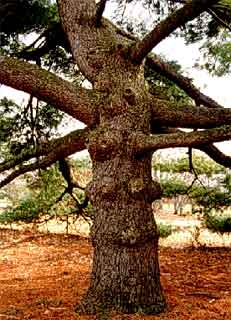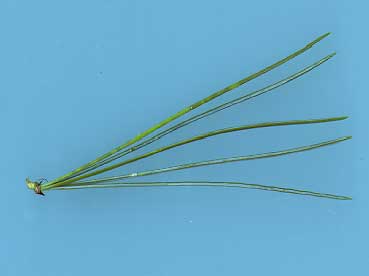 Eastern White Pine - Pinus strobus
Eastern White Pine - Pinus strobus
Pine Family (Pinaceae)
Although white pine occurs frequently in Kentucky, it is more at home in more northern states. It tolerates shade when young and can be abundant on rich hillsides in the Red River Gorge associated with hemlock. The Kentucky champion tree is in McCreary County and is nearly 150 feet tall.
 Culture: This evergreen is an excellent ornamental tree but will not thrive if growing conditions are not optimal. It grows best in fertile, moist, slightly acidic, well-drained soil with full sun. It tolerates some shade but suffers in saturated, hot, dry, infertile, compacted, alkaline or heavy clay soils. These conditions cause a physiological problem on young and recently transplanted trees known as white pine decline. Trees with this condition decline until they have only small clusters of short, stunted needles at their branch ends. White pine is susceptible to damage by road salt, air pollution, wind, ice and snow. It is susceptible to white pine root decline, caused by a fungus, and the potentially lethal white pine blister rust disease. Eradicate gooseberry or wild currant bushes from the planting area as they harbor rust. The list of potential problems includes infestation by white pine weevil, European pine shoot beetle and European pine shoot moth.
Culture: This evergreen is an excellent ornamental tree but will not thrive if growing conditions are not optimal. It grows best in fertile, moist, slightly acidic, well-drained soil with full sun. It tolerates some shade but suffers in saturated, hot, dry, infertile, compacted, alkaline or heavy clay soils. These conditions cause a physiological problem on young and recently transplanted trees known as white pine decline. Trees with this condition decline until they have only small clusters of short, stunted needles at their branch ends. White pine is susceptible to damage by road salt, air pollution, wind, ice and snow. It is susceptible to white pine root decline, caused by a fungus, and the potentially lethal white pine blister rust disease. Eradicate gooseberry or wild currant bushes from the planting area as they harbor rust. The list of potential problems includes infestation by white pine weevil, European pine shoot beetle and European pine shoot moth.
- Native habitat: Northeastern U.S., following the Appalachians south.
- Growth habit: Pyramidal with tiers of branches coming off the trunk at right angles. With age, the tree becomes flat-topped and has an attractive, characteristic outline.
- Tree size: Fast-growing tree, reaching 50 to 80 feet tall in the landscape with a spread of 20 to 40 feet. Can exceed 150 feet tall in the wild.
- Flower and fruit: Monoecious; male flowers are yellow and clustered; female flowers are pink. Ornamental, 3- to 7-inch-long hanging cones are pale brown at maturity and very resinous. Leaf - Long (4-inch), blue-green needles, soft, flexible and grouped in fives. The aromatic needles usually drop after two or three years after they turn yellow in early fall.
- Hardiness: Winter hardy to USDA Zone 3.planting area as they harbor rust. The list of potential problems includes infestation by white pine weevil, European pine shoot beetle and European pine shoot moth.
There are as many as 30 cultivars of white pine. Selected cultivars include:
- ‘Compacta' - A dense, compact cultivar with a roundish shape.
- ‘Contorta' - A rare cultivar with slightly smaller needles and cones than the species; semi-dwarf. Branches and needles are twisted.
- ‘Fastigiata' - Upright, columnar form, can reach 30 feet or more in height. Remains narrow as it matures.
- ‘Nana' - Dwarf, bushy with small needles and cones.
- ‘Pendula' - Weeping white pine is the best-known cultivar. It is semi-dwarf with pendulous branches.
 Additional information:
Additional information:The wood of the white pine is exceptionally light and strong, resists warping and is easily cut in any Pinus strobus (Eastern White Pine) Pine Family (Pinaceae) pg.2 Additional information (continued): direction. When settlers moved westward they found primarily hardwoods. Not wanting to rely on the difficult-to-cut hardwoods for their coffins, "coffin pines" (white pines) were planted at new homesteads. White pine was once the dominant tree in its range and the tallest native tree in eastern North America. Primeval white pine forests towered to 250 feet when Europeans first discovered this bountiful resource.
 The quality of the wood and the long straight stems have made it ideal for many uses, particularly as shingles and ship masts. American colonists relied on white pine as one of their few exports, along with fir and fish. Alarmed by the colonists' "timber stealing" from the crown's land, William and Mary decreed that the best specimens were to be saved for the Royal Navy and their agents marked those trees with the royal emblem. The colonists' anger toward Britain's intrusions was fueled by these visible reminders and the ownership of the white pine trees was a major motivating factor for the American Revolution. After independence was obtained, the reckless exploitation of the towering white pines started in New England and moved through the Great Lakes states. Lumber was America's No. 1 natural resource until the timber ran out in 1900. When the northern white pine was logged out, the lesser-quality southern white pine of the Appalachians was logged until it was depleted. In certain parts of the U.S., white pine blister rust limits the utility of eastern white pine. The disease kills the main branches of the pine and can be fatal. The rust organism uses wild and cultivated currants and gooseberries (Ribes spp.) as alternate hosts and so is more of a problem in northern areas where currants grow wild.
The quality of the wood and the long straight stems have made it ideal for many uses, particularly as shingles and ship masts. American colonists relied on white pine as one of their few exports, along with fir and fish. Alarmed by the colonists' "timber stealing" from the crown's land, William and Mary decreed that the best specimens were to be saved for the Royal Navy and their agents marked those trees with the royal emblem. The colonists' anger toward Britain's intrusions was fueled by these visible reminders and the ownership of the white pine trees was a major motivating factor for the American Revolution. After independence was obtained, the reckless exploitation of the towering white pines started in New England and moved through the Great Lakes states. Lumber was America's No. 1 natural resource until the timber ran out in 1900. When the northern white pine was logged out, the lesser-quality southern white pine of the Appalachians was logged until it was depleted. In certain parts of the U.S., white pine blister rust limits the utility of eastern white pine. The disease kills the main branches of the pine and can be fatal. The rust organism uses wild and cultivated currants and gooseberries (Ribes spp.) as alternate hosts and so is more of a problem in northern areas where currants grow wild.
Although white pines are considered evergreen, the needles do show yellow autumn color and fall off the tree. A needle may persist as evergreen for two or three years before falling to the ground. In the proper site location, eastern white pine can make an excellent large background screen. Eastern white pine takes shearing very well. This should be done after the new growth starts. Never prune back to bare wood.
Co-national champion eastern white pines, both in Michigan, are 201 and 181 feet tall.



